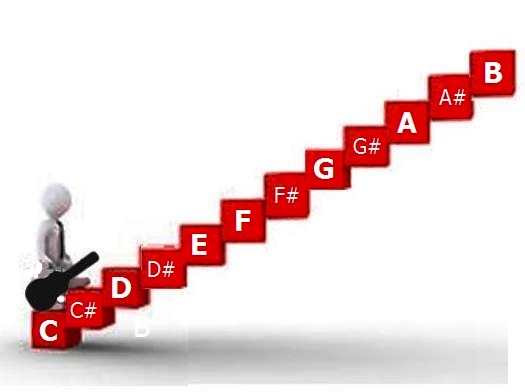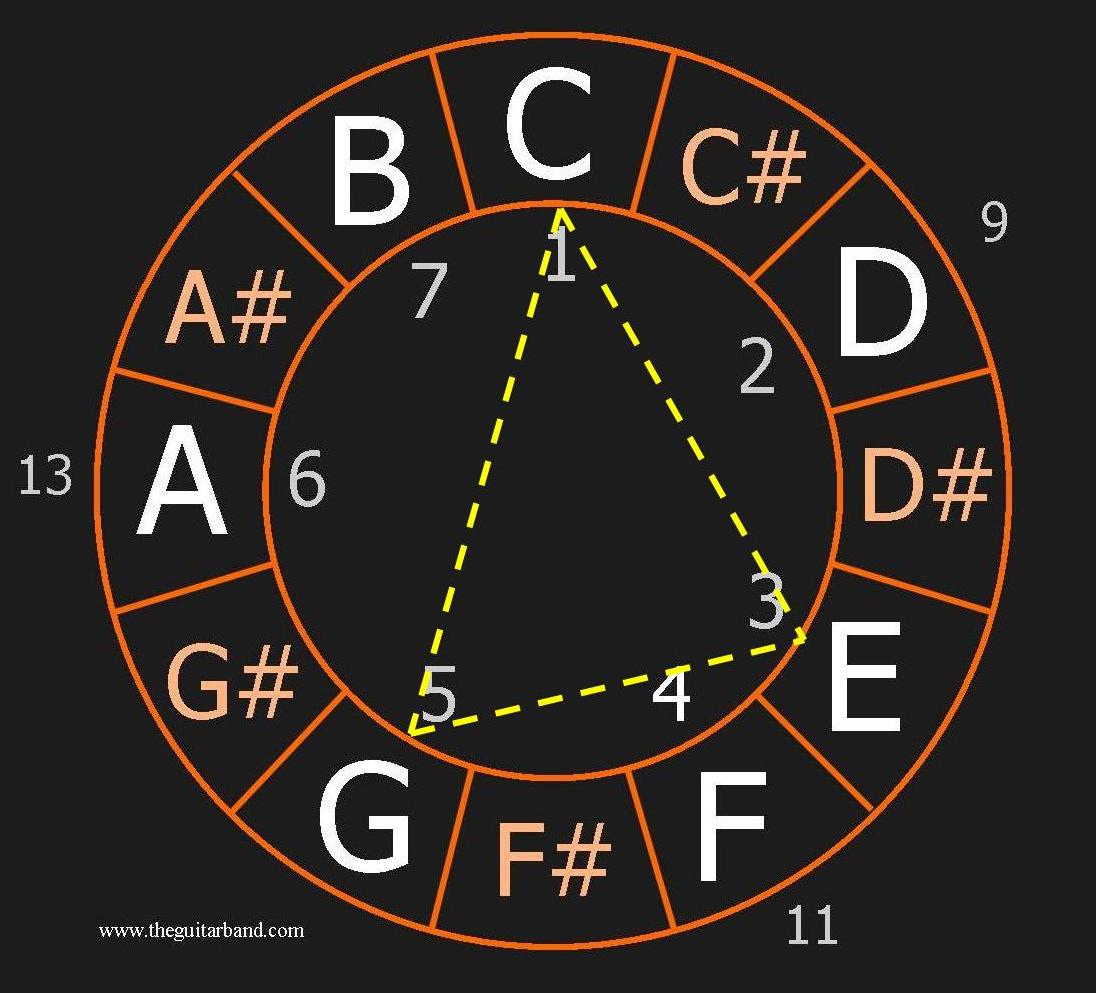The scales are very important. From them you can write down the notes of every kind of chords.
This is an easy way of learning the scales emphasizing the most important notes without weighing down the content with too many symbols.
Diatonic Scale and Chromatic Scale

This is a scale of letters, from A to G: A B C D E F G A B C D E F G A B… where every letter in music is a sound.
Numbering the 7 notes from 1 to 7, starting from C
C D E F G A B
1 2 3 4 5 6 7
This is called DIATONIC SCALE as only include main notes.
But musical notes are 12 in total, 7 main notes + 5 positioned between them.
This succession of 12 notes is called the CHROMATIC SCALE (From the Greek, Chrome = Color, 7 colors with their shadows, the semitones).
It’s very important to focus on it, as 90% of the guitar theory lies here.
Observe the same scale on the second string of the fretboard (Starting from C, on the first fret of the B string):
B String ||--C-|----|--D-|----|--E-|--F-|----|--G-|----|--A-|----|--B-|--C-|...
The notes C D E F G A B build a diatonic scale (7 notes).
Adding the notes included in the dashed spaces (semitones) we get a chromatic scale (12 notes).
Between C and D there is a note called C# (or Db), between F and G there is F#, etc. No Notes between E and F, B and C.
This is the C major scale (in Western music, major is the “default” scale).
- C is the 1st (the Tonic)
- E is the 3th
- G is the 5th
- etc.
These numbers are used in the name of the guitar chords. Ex. C7, F13, Am6, C7/9, etc.
But not in number 8, 10, 12 (the number 2 is is often replaced by 9).
Now if you see a chord like C6, you know there is also the note A (the 6th) in the chord.
Tone and Semitone
In the most important scale, the Major Scale, the distance between C and D is 1T (1 Tone). Between E and F is 1s (1 semitone), etc.
The complete formula is: T – T – ST – T – T – T – ST (Intervals of the major scale)
Every major scale must have these intervals between the notes.
It’s easy to find notes of every major scale starting from the Major scale looking at the distances between them.
This table shows the seven most important Major Scales and is very useful to find every type of chord. Note that between the 1st and the 3rd there is always a distance of 2 Tones (Major Scales).
E.g. Look at the scale of F . A is the 3th, Bb is the Forth, C is the 5th etc. In every different scale you should count the distance between the notes.
Next is the Chromatic Scale with all the notes, but in circular shape. Circle of 12 Notes:
With this circle it is easy to identify also the 9th,11th, 13th. This notes has large use on the chords.
Major Chord
A basic chord is made out of three notes in the chromatic scale.
A Major chord, e.g, such as C, is made up of the notes number 1, number 3 and number 5 (C, E, G). First Note, Third Note, Fifth Note.
I choose the C chord because it has the easiest scale with no sharps or flats. Of course, you can apply this technique to other chords as well.
Somebody write as C Major. If you find only C alone, this means it is a Major chord. The term Major can create confusion, because Cmaj (or Cmaj7) don’t means C major but “C major with the Major 7” (C, E, G, B).
What confused beginners with major and minor is normally the third defined if major or minor. In the case of a Cmaj7. The “major” word used in the chord name has nothing to do with the third but on the 7th. This brings confusion.
Distance between the First and the Third: 2T (2 tones, or 4 semitones).
This is very important for if this distance is less (ex. 1T+1s) then we get a Minor chord. The Minor Chord is relative to the Minor scale (note number 3 down 1s, can write as b3). Changing E with Eb we move from the C major to the C Minor (also from the C major scale to the C Minor scale).
Distance between the Third and the Fifth: 3s (3 semitones).
For the chord construction count the semitones:
C +4s = E E + 3s = G (C Chord).
Every major chord has the same formula. E.g.:
- G: G +4s = B G + 3s = D (you can count the semitones in the circular scale).
- F: F +4s = A A + 3s = C F ( F, A, D )
- Bb (A#): Bb +4s = D B + 3s = F Bb ( Bb, D, F )
- Gb (F#): Gb +4s = A# A# + 3s = C# Gb (Gb, A#, C#)
Etc.
Note that the chords as C7, A7 etc, don’t have the 7th note but the 7b. C7 = C, E, G, Bb (1, 3, 5, 7b).
Major Chord in the Circle of Chromatic Scale. Turn the Triangle and get any Major chord.

Discover the latest musical instruments on our music website on Amazon!
Explore the latest musical instruments on Amazon music store and support our channel at no extra cost to you! By purchasing any musical instrument through our affiliate link, you not only get top-quality gear but also contribute to our channel's growth and content creation.

 Join our Telegram group: Band in a Box Backing Tracks.
Join our Telegram group: Band in a Box Backing Tracks.
 Join our Facebook group (download/share backing tracks): SGU BackingTracks
Join our Facebook group (download/share backing tracks): SGU BackingTracks








I only see the d major scale with C# as 7th note (ahhhh! Perhaps, it was wrong before? And, now corrected? Either way, kudos to both of you. ?
PS this is great info detail, THANKS!
Hi Joseph, yes, I think now it’s correct (C#). Thank you for your feedback
please rectify the D major scale chart….7th note will be C# not C
Many thanks for your feedback, it has been taken notice.